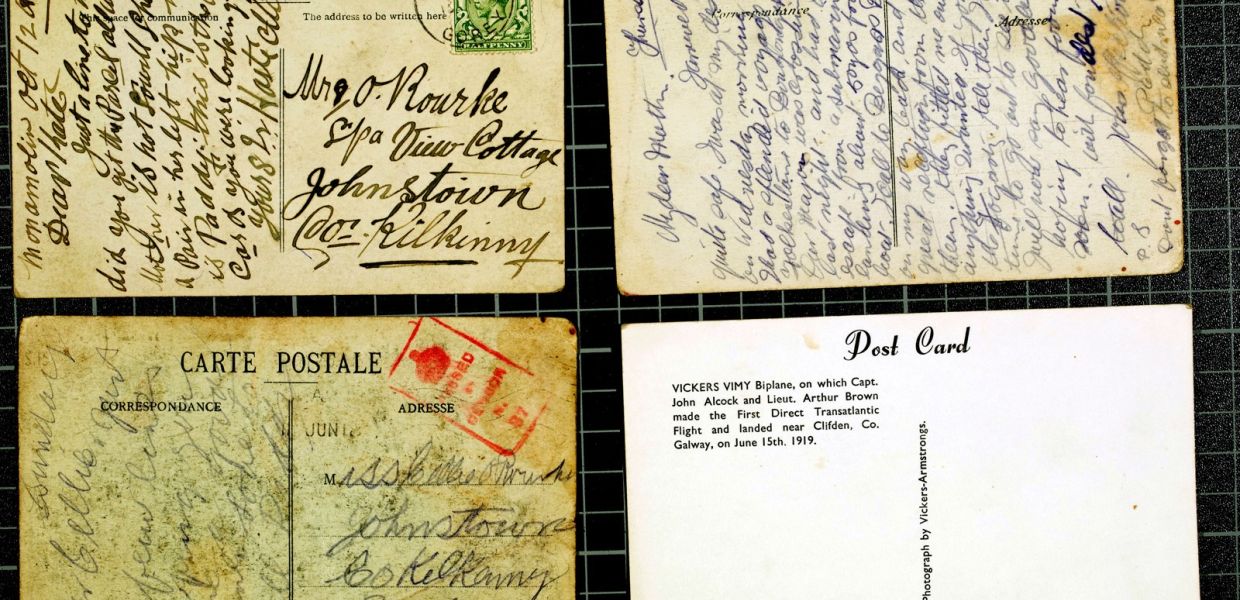Making the invisible visible: Six cultural heritage institutions share the pitfalls of clearing rights for 20th century collections

- Title:
- Postcards contributed by members of the public to Europeana 1914-18: Postcards of Patrick and John O'Rourke, contributed by Kay Ryan,
- Institution:
- Europeana 1914-18
- Copyright:
- CC BY-SA
What do a poster from an anti-Vietnam demonstration, monographs about German exiles, Belgian fashion company archives and a unique body of 6700 Dutch amateur films dating from the 1910-1980s have in common? All are protected by copyright but were never created with commercial intent. As they are all housed in various cultural heritage institutions across Europe, they have all ‘acquired’ the status of being recognised as signifiers of social and cultural importance.
The tension between respecting copyright, which prevents institutions publishing such works, whilst also fulfilling the primary role of museums, libraries and archives - to encourage the public to discover and learn about their own cultural heritage - has become more present in a digital space. Platforms such as Europeana and other digital projects provide a way to reach new audiences for collections, and people who may never otherwise be able to see these cultural treasures - but only if copyright allows.
Many organisations hold 20th century materials by well-known authors and creators which are of high commercial value. There is also a vast amount of material ranging from core collections and archives such as books, photographs, monographs and film, to more unusual and ephemeral objects like posters, cards, flyers, brochures, legal texts, banners, street signs, buttons, etc. Often these have important socio-cultural value and were not created for commercial sale.
These collections vary in terms of why they were created and what they represent. However they share a common theme. Most 20th century works are protected by copyright if the term of life of the creator plus 70 years (for most works) has not expired. This means that legally permission should be obtained from the copyright holder before a work can be re-used in any way.
However this presents several challenges for cultural heritage institutions including the time and cost involved in identifying and contacting copyright holders and the legal uncertainty on what a CHI can make available in line with legal frameworks such as the European Orphan Works Directive.
The need for change
In practice, these collections often remain hidden behind closed doors, and in drawers and vaults, never to see the light of the digital day. The lack of 20th century material online is highlighted in our factsheet ‘The 20th Century Black Hole: How does this show up on Europeana?’, and reinforces the position Europeana Foundation and its Network outlined in an Open Letter to the European Commission in October 2015 expressing the need for a change in current copyright rules to make it easier to access cultural heritage online.
To support the European Commission with their aim to make it easier to publish out-of-commerce works online, as outlined in their communication on copyright reform in 2015, we have worked with 6 institutions representing museum, library and archive collections. They kindly shared their first-hand experiences of balancing the practical day-to-day management of their collection and the expectations in making them available to the public, together with the difficulties they have in clearing rights for digitising certain types of material and making them available online.
We have drawn up case studies about their experiences which we share with you today.
Evidence suggests that cultural heritage institutions largely make decisions on what to publish based on what is likely to be in the public domain, not an Orphan Work, and how much time is likely to be involved to clear rights when there is more than one rights holder for one work. The cost for rights clearance varies hugely and often exceeds the economic value of the work itself.
In summary, there is good practice for clearing rights within cultural heritage institutions but this could be made easier, more cost-effective and, importantly, allow for more out-of-commerce 20th century material to become visible online with updated copyright rules.
To read more about the challenges museums, libraries and archives face in tackling rights clearance of out-of-commerce 20th century material, see the full case study report here.
